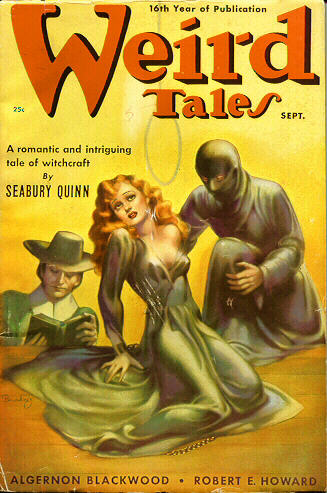Howdy-do!
Today I’m going to be following along the course of my previous entries on brujeria/curanderismo and Catholic folk magic in general by looking at some specific elements, tools, charms, and spells from within those traditions. I should go ahead and note that while Psalm magic is found within all of these streams, I’m not covering it here because it is a huge topic in and of itself, and one which I’ve already explored a bit in posts 115 and 116. I’ll also only briefly touch on any Saint-specific magic, because that could be its own topic, too (and hopefully will be at some point).
That being said, I would like to point out the presence of a number of folk saints in pseudo-Catholic magical practices. These are not officially recognized saints (even Mother Theresa and Pope John Paul II have not been fully canonized yet), but rather people reputed to be intensely holy and capable of performing miraculous feats. They can also be spirits with special powers and areas of influence who do not have a human counterpart, but rather seem to be almost archetypical entities. Some of the most widely petitioned and patronized of these folk saints include:
- Don Pedrito Jaramillo – healing
- Teresa Urrea (“Teresita”) – healing
- El Nino Fidencio – healing & spiritual purification
- Santa Muerte (“La Santisima,” “La Huesada”) – protection, prosperity, family life, love, and a number of other powers
- Saint Michael (Archangel) – protection & spiritual warfare
- Saint Raphael (Archangel) – safe travels, spiritual medicine, & exorcism of evil spirits
(for more information on these folk saints, see Curandero by Cheo Torres and Magical Powers of the Saints by Ray T. Malbrough)
Many people simply burn candles with images of these saints emblazoned on the glass or with picture prayer cards placed nearby. Small votive offerings might be left out for them, including small amounts of liquor, coffee, or tobacco, or specific items might be given to specific saints. For example, Saint Michael’s altar would be decorated by war memorabilia, such as medals, maps, or pictures of soldiers. More explicitly spell-like operations can also be performed, such as this method for creating a powerful “fortune magnet”:
Get a candle or statue of Santa Muerte and put her on an altar by herself (she does not like to share altar space, though she has been known to tolerate St. Michael at times). Place a lodestone beside her, and a glass of water on the other side of her. Put a basket of brightly colored fruit (lemons and oranges, for example) in front of her, and place yellow flowers upon her altar. Light a charcoal in a brazier and burn a holy incense (such as Gloria Incense or even just some frankincense). Add a pinch of soil from your homeland (or even hometown) to the burning coal, and say:
Towards you I inclilne, Holy Lady
I bring you water and yellow flowers,
Incense and the dust from which I am made.
Please make the world to twist and turn,
Allowing luck and fortune to cross my path,
Cutting the bitter ties that bind me.
In your honor I shall please you with scented offerings,
I shall plant trees in forests,
I shall give you fruits
In return for your goodwill towards me.
Allow the candle to burn for at least an hour. If possible, allow the candle to burn out on its own. Let the stone sit overnight, rising before dawn and wrapping it in a dark cloth. Keep this with you at all times, and do not unwrap it in direct sunlight. [Adapted from a spell in an anonymously authored chapbook called The Magical Powers of the Holy Death picked up in a botanica]
How’s that for not dwelling on Saint magic? Moving on, then, let’s look at some other spells from other sources. This one, which I’m transcribing from The Red Church and which comes from John G. Hohman’s Long Lost Friend, is not explicitly Catholic, but the presence of latinate words and Christian symbols certainly allows it to fit right in with the whole “magical Catholic” idea:
A Written Charm of Exorcism
Below is a charm paper entitled ‘Against Evil Spirits and Witchcrafts.’ This charm was given to me by ‘Daisy.’ With the exception of a few minor details it is exactly like the one that appears in Hohman’s The Long Lost Friend…
N. I. R.
I.
Sanctus. Spiritus.
I.
N. I. R.
I.
All this be guarded, here in time, and there in eternity. Amen. +++ (TRC, p. 273-4)
Chris Bilardi goes on to describe several ways in which you might deploy this charm, including folding it into a tight triangle and slipping it into the frames and jambs of doors and windows in your home (but you must use no metal to affix it). He also mentions putting it into a wallet or binding it with a red string if it is intended to be carried.
Another home protection and blessing charm comes out of ancient Jewish practice, too. Joshua Trachtenberg’s quintessential text on the topic, Jewish Magic & Superstition, describes an excellent blessing charm which consists very simply of bread and salt either ingested to defeat evil spirits or brought into a new home “as a symbolic of the hope that food may never be lacking there” (JM&S p.161). In my own family, we called this the ‘Polish House Blessing’ and included a penny as well (we were Polish through my grandfather’s family). It’s something I still use when someone mooves into a new house in order to bless their new home. I simply put the salt (kosher, please), a piece of bread, and a penny in a small jar (like a baby food jar) and wrap the lid in pretty paper, often with a Psalm written on the underside of it to provide protection and domestic bliss (Psalms 46 and 61 are both good for this).
One of my personal favorite books of the Bible is Jonah, which is also one of the shortest books in the whole book. It’s read every year on Yom Kippur in synagogues, and it has a bizarre blend of folklore, humor, and philosophy in it that I just find delightful. For a magical practitioner, it can also be a very good source of magical phrases. One very simple spell which Draja Mickaharic lists in his Magical Spells of the Minor Prophets is for abating someone’s anger:
To Turn Away Another Person’s Anger
Required: Only the verse
Spell: In the presence of an angry person, say the verse to yourself three times.
Verse: Jonah 4:4 (“Then said the lord, Does thou well to be angry?”)
NOTE: This verse should be memorized and used for this purpose whenever desired (MSMP, p. 52-3)
There are a number of great non-Psalm verses that can be used for various magical purposes. Most of these are simply spoken, though sometimes they can be written down and carried in pockets, purses, etc. for magical aid. A list (hardly exhaustive) of such verses:
- Amos 2:13 – Against an Opressor
- Obadiah 1:6 – To Find that Which Has Been Lost
- Habakkuk 2:2-3 – For Aid in Automatic Writing
- Zechariah 4:13-14 – To Learn Who Your Teacher or Guide Is
- Ezekiel 16:6 – The Blood Verse (for stopping small wounds)
- Genesis 49:18 – For Protection at Night
- Deuteronomy 18:13 – Against Wild Beasts
- Deuteronomy 33:3-4 – For Intelligence
(The above primarily from Magical Spells of the Minor Prophets and Jewish Magic & Supersition)
I’m sure with enough effort, nearly any book of the Bible will yield some magical content, though I’ve not tested that theory.
Finally, I couldn’t reisist including some of the “popish and magicall cures” found in Reginald Scot’s Discoverie of Witchcraft. The following are cures “For direct cure to such as are bewitched in the privie members” (i.e. to deal with impotence, especially impotence caused by witchcraft):
For direct cure to such as are bewitched in the privie members, the first and speciall is confession: then follow in a row, holie water, and those ceremoniall trumperies, Ave Maries, and all maner of crossings; which are all said to be wholesome, except the witchcraft be perpetuall, and in that case the wife maie have a divorse of course.
- Item, the eating of a haggister or pie helpeth one bewitched in that member.
- Item, the smoke of the tooth of a dead man.
- Item, to annoint a mans bodie over with the gall of a crow.
- Item, to fill a quill with quicke silver, and laie the same under the cushine, where such a one sitteth, or else to put it under the threshold of the doore of the house or chamber where he dwelleth.
- Item, to spet into your owne bosome, if you be so bewitched, is verie good.
- Item, to pisse through a wedding ring. If you would know who is hurt in his privities by witchcraft; and who otherwise is therein diseased,Hostiensis answereth: but so, as I am ashamed to english it: and therefore have here set down his experiment in Latine; Quando virga nullatenùs movetur, & nunquam potuit cognoscere; hoc est signum frigiditatis: sed quando movetur & erigitur, perficere autem non potest, est signum maleficii. [Dialect from original text preserved here]
I hope this post has been entertaining and interesting for you. Please also check out the recent posts on curanderismo and Catholic folk magic, as well as our most recent episode on biblical sorcery.
I don’t know if I’ll get another post up before the Salem trip, so if I don’t, I will hope to see some of you there. And the rest of you I’ll look forward to speaking to when I get back!
Thanks for reading!
-Cory




